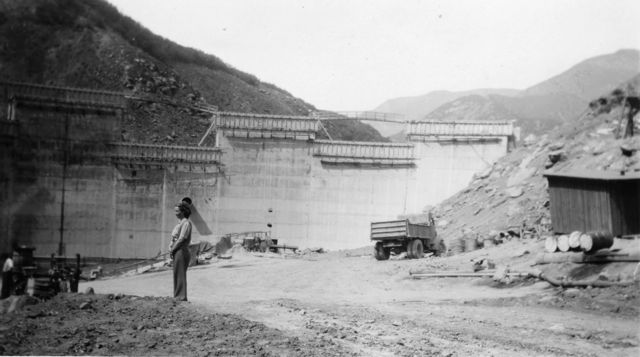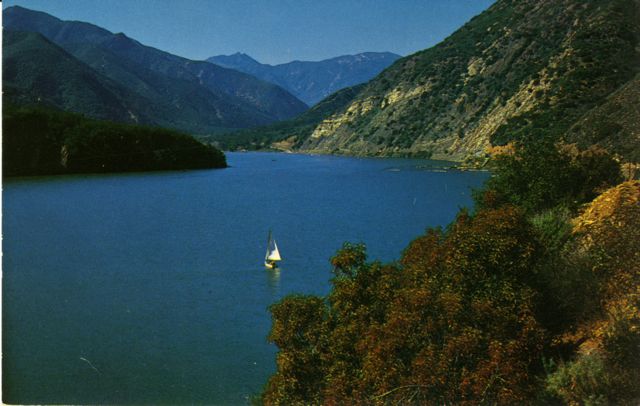The following article first appeared on the front page of the Friday, January 19, 1951 edition of “THE OJAI.” That newspaper is now the “Ojai Valley News.” The article is reprinted here with their permission. The author is unknown. The headline was RECHARGE BASIN SAYS WATER CO.
Recharge Of Ojai Basin by Purchase of Matilija Water Proposed to District
Appearing before a meeting of the San Antonio Water Conservation District, L. J. Alexander, chief engineer of the Southern California Water company brought forth a plan whereby the hopes of the underground water basin of the Ojai Valley may be recharged.
Basically, Alexander proposed that all water users of the Valley cooperate 100 percent in an effort to purchase water from Matilija dam to be put in spreading grounds at the terminus of the second unit of the conduit from the dam, now nearing completion.
He gave a brief history of water in the Valley, stating that in a survey by the division of water resources in 1933-36, it was estimated that the mean annual recharge of the basin in the Ojai area would be 5000 acre feet. At that time approximately 1500 acres were being irrigated in all classes and categories in the Valley.
“Recent studies show,” Alexander continued, “that there are now 1500 acres in citrus alone, with 2700 acres susceptible to cultivation. There are some 3000 acres under irrigation at present. With this great increase, there is not enough water here now for all the developments going on.”
When asked what were the boundaries of the 1500 acres in citrus, Alexander said they lie east of a geologic formation one-half mile west of the junction of highways 150 and 399.
The Water company official estimated that the Valley needs 5000 acre feet of water per year. “There will be between 3000 and 3500 acre feet available this summer,” he said, “and someone is sure going to go dry. Last year on the fringe areas of the district some growers lost oranges, some lost groves. The revenue based on the citrus crop in the early part of 1950 definitely surveyed less than in other years. The situation brought about a definite economic loss.”
“Rain is what we need,” he remarked. “I don’t know how to make rain. We are here with a common problem.”
As a solution to this problem, Alexander said, “The pipeline (Matilija conduit no. 2) is here, and the problem is to get water into it. If there were 1500 acre feet available in Matilija that could be used in the Valley, that would make up the deficit.”
At an arbitrary cost of $20 per acre foot, Alexander pointed out that the water would cost $30,000.
“Let’s assume the water is there and we can get it,” he told the gathering. “That would mean $30,000 per year for water in this area. Only a few could get benefits from the pipeline by tieing into it directly, but by putting the water into the ground through spreading grounds and letting everyone pump, it would be there for all.”
He likened the Ojai water basin to a big bathtub filled with gravel. “As long as we keep the water here, everyone who has a “straw” in the tub can get it out,” he said. “This is the easiest way to get water to everyone. It doesn’t matter where you put it in the basin, it will recharge all the levels. Wells within a half-mile area (of the dumping area) would feel immediate benefit. The outlying fringe would feel the recharge in time.”
He cited similar plans which have been instituted in Orange county, Claremont and the Central Basin area in south Los Angeles, and which are under successful operation. He continued to stress emphatically the idea that the entire district should give complete cooperation to the problem, and should enter into a contractual agreement to obtain Matilija water.
“I can’t see any reason for Ojai if we don’t have citrus and agriculture,” the engineer said. “The merchants don’t bring money into the area. The basic income is agriculture, and if we destroy it, there is nothing left.”
He told the group that the Water Company is obligated under state law to supply its customers to the “last ditch.” “We’ll do it as long as we can,” Alexander said, “and when the supply runs dry, there’s nothing else we can do. If we have to haul water in here in trucks, you ranchers will all be gone, and there will be few people left in Ojai. The situation has been dog eat dog for the past two years. Not too long ago our wells were flowing. We are looking forward to pumping at 320 feet this year. The water level is lower than it has been since 1927. The reason for this is the tremendous development which has resulted in the 1500 acres in citrus, plus 1500 acres more in other use, with the additional domestic use.”
Returning to the figure of $20 per acre foot for Matilija water, Alexander stated that it would cost the users $8 per acre foot if the cost were shared equally by all users on a percentage basis. He explained that since the Valley requires 5000 acre feet per year, and the cost of importing 1500 acre feet to make up the shortage were $30,000, paying on a basis of benefits received would put the cost in the neighborhood of $8 per acre foot.
The suggestion of meters for pumps was advanced as an advisable solution to the equitable division of cost.
“The situation must be approached completely, honestly and with full cooperation,” Alexander emphasized.
“There might be 3500 acre feet of water available to the Valley this year with some rains, something should be done to develop cooperative means to take action along the lines I have suggested,” he said. “No matter what you do, the Southern California Water company will play ball all along the line.”
Explanation was made that the District could not take such action as was suggested under present law, since the rate is established on an ad valorem basis, but Alexander stated that the state legislature is being asked for an amendment in Orange county, which might be applied to other areas as an enabling law, so that each area could set up on a use basis.
Supervisor R. E. (Sam) Barrett told the gathering that with Matilija dam as a sole basis, he took dim view of any irrigation water being available. He repeatedly stressed the importance of the construction of a second dam, which would greatly increase the safe yield of Matilija.
Mr. Hoit Vicini, vice president of the Southern California Water company explained briefly that his company had only brought forward ideas which they had found in other areas which they felt might be helpful. “We came to go along with what you decided,” he said. “If there is no copious rain, a serious situation will develop. We hope to preserve the fertility of the Valley, and to work out the problem on an economic basis, so no one will get hurt.”
Alexander added that the company would be ready to assume its share of the cost of the proposed project on a percentage basis. He also stressed the point that the company has nothing to sell in the matter, but wishes to bring information to the District that might be of help to all in the solution of the water supply of the Valley.
ENGINEERS’ REPORT IS EXPECTED TO BE FOLLOWED BY CALL FOR BOND ISSUE
The following article first appeared on the front page of the Friday, July 9, 1949 edition of “THE OJAI”. That newspaper is now called the “OJAI VALLEY NEWS”. The article is reprinted here with their permission, The author is unknown. The front-page headline was “OAKS PLANS NEW WATER SYSTEM“.
ENGINEERS’ REPORT IS EXPECTED TO BE FOLLOWED BY CALL FOR BOND ISSUE
A definite and important step in securing a new water system for Meiners Oaks was taken Tuesday night when the Board of Directors of the Meiners Oaks Water District formally adopted the preliminary engineering report of John A. Dron, Ojai civil engineer. The report as presented by Mr. Dron recommended:
(1) The construction of a storage reservoir with a capacity of 870,000 cubic feet or over 6,000,000 gallons of water;
(2) The separation of the domestic or household supply from the irrigation use;
(3) The installation of a complete new piping system, ranging from 16-inches down to a minimum of 4 inches, with 52 6-inch hydrants and 39 four-inch hydrants for fire protection, and
(4) The establishment of a complete metering system.
Meeting July 26
Upon the adoption of Mr. Dron’s report, the Board discussed the proceedings that were necessary to call for a bond issue, and decided to hold a public meeting on the evening of July 26 at the Church of Christ building in Meiners Oaks when the engineering plan and the methods of financing it would be outlined, and further proceedings be determined. After considerable discussion the Board resolved to go into the matter of a bond issue to cover the cost of the new system and to purchase the assets of the present Company, the Rancho Ojai Mutual Water Co., which would then go out of existence.
Bond Election
After the general meeting as scheduled, the Board proposes to call an election for the bond issue, as soon as the necessary legal steps have been taken. William Selby, attorney for the District stated that he believed that the issue contemplated was reasonably within the bonding capacity of the District, and that there should be no difficulty in selling the bonds, which the Board tentatively decided would run for 25 years.
Irrigation vs. Domestic Use
In presenting his report, Mr. Dron emphasized that the difficulty the community has experienced in their water system has arisen largely from the fact that there is no present storage, and the dual use between domestic and irrigation demand has been in conflict. He therefore had designed the new system to completely divorce the irrigation use from the domestic use.
The water stored in the reservoir would be sufficient, under normal circumstances, to supply all householders for nearly a month, and would reach them under a gravity head with enough pressure to give ample volume at all times and for all purposes. The irrigation use would continue to be supplied through existing lines under low pressure and all together independent of the reservoir.
Metering System
He also pointed out that the sole revenue of the district for operating expenses and for retiring the cost of a new system, was the sale of water, and that therefore meterage to all consumers was imperative. His plan provided accordingly, and a complete metering system was included in the new project.
As soon as the matter has been publicly considered at the general meeting on July 26, the Board proposes to proceed with the necessary legal steps calling for an election on the bonds. If this is carried, then funds should be available about the first of the year for construction contracts.
The Board also directed William Selby to represent the District at an announced meeting of riparian owners of the Ventura river and representatives of the Zone One Water District, when the matter of releasing sufficient water from the Matilija Dam to maintain a constant flow in the river will be taken up.
That was the end of the front page article, but another article concerning the matter was on PAGE THIRTEEN:
HERE ARE PERTINENT PARAGRAPHS FROM THE DRON MEINERS OAKS WATER REPORT
GENERAL.
1. Acreage: The area considered in the report, which has been incorporated as the Meiners Oaks County Water District under the County Water District Act of 1913, as amended, comprises about 960 acres of residential and agricultural land, a part of the Rancho Ojai, lying in and along the east bank of the Ventura river as it debauches from the Santa Ynez range into the westerly extension of the Ojai Valley.
The approximate acreages in each classification are as follows: Residential, 210 acres with about 509 dwellings; Agricultural, 245 acres in citrus and other crops; River bottom, 180 acres of poor land, non-arable, with some housing; Upland or hilly, 325 acres of pasture or brush.
2. Population: Accurate population figures are not available, but estimates based upon the number of water consumers and upon a school census indicate a present population of 2,500. Recently the population, as in general throughout adjoining areas, has rapidly increased, and there is every indication that the increase will continue so long as land and water is available for further development. It must be emphasized that the future growth is dependent upon an adequate water supply, which even now is wholly insufficient during the summer months.
3. Water Sources: The present water supply is derived from a primarily riparian water right to the natural flow of the Ventura river amounting to 231 miners inches (one miners inch equals nine gallons per minute) plus water derived from three wells in the river bottom, two of which were drilled in 1948. The supply from these wells is insufficient to augment the natural flow, which during the present dry cycle of rainfall is greatly below normal
In the future, water may become available from the recently completed Matilija dam on the west fork of the Ventura river, and it may be necessary for the District to contract for a stipulated amount of unappropriated surplus water from the Zone One Water District.
4. History of Water System: In 1928 the Rancho Ojai Mutual Water Company was incorporated and took over the elements of a water supply, as it then existed, from the Ojai Ranch and Development Company, the active subdividers of Meiners Oaks. From about 1931 the system has been operated and gradually extended and improved by the Mutual Company.
Conditions of supply became so serious in the summer of 1948 that improvement became imperative. There being no storage except the water in the intake lines, the dual demand from domestic and irrigation users came into conflict, and it was necessary to schedule the latter use to certain days of the week.
Frequently householders were able to draw water for the most essential domestic use. This condition was aggravated by the impaired condition of the domestic distribution lines which, not alone being undersized to begin with, had become so corroded that their capacity was decreased by 30 per cent. Furthermore, these lines had been placed down alleyways between blocks, which had been abandoned for public entrys and inevitably became so obstructed by fences and outbuildings that the pipelines were inaccessible.
THE ENGINEERING PLAN
1. Water Supply: For the time being nothing can be done about this beyond drilling additional wells . . . but it is suggested that an effort be made to contract with Zone One for additional water from Matilija Dam storage, to supplement the riparian diversion from the river. The District would then be in an advantageously prior position in getting water when necessary, and undoubtedly if the water was not required could sell it to other users until such time as it was needed.
2. Storage: Perhaps the most glaring deficiency in the present system is the lack of any storage capacity. As matters stand the sole water available for emergency or peak demand is that backed-up in the intake line, and when the intake of water is low the pipe had no more water in it than the amount flowing under gravity. There are times when, if a fire should occur there would not be enough water available to supply a hydrant. Once a fire gained headway in the Oaks, under hazardous weather conditions nothing could stop it and the whole community could be wiped out.
From this consideration alone, if no other, the location of a suitable storage site became of prime importance.
A primary survey of the ground discovered a prospective site that upon detailed investigation seemed to fulfill the need admirably. This is located on the NE corner of Lot 3, Section T-4-N, R-23″ S. B. B&M. Water from the intake line could be delivered to the dam at a surface level of Elev. 910 feet above sea level, with a 100-foot lift. A storage capacity of approximately 20 acre feet (871,000 cu. ft. or over 6 million gallons) can readily be obtained at an elevation which will give a house delivery from 50 to 60 lbs. per sq. in. pressure.
3. Distribution System: The present domestic distribution system is so rusted and so small in size that it cannot serve users properly. Furthermore, it is located in the inaccessible center of the occupied blocks. From these considerations it was decided that the whole system might well be abandoned and a completely new distribution system constructed.
The new distribution system would run from the reservoir down the Maricopa road to the intersection of Meiners, Tico and Fairview roads. It would bifurcate at this point, a 12″ main running down the east side of the populated district generally along Lomita Avenue, and an 8″ main running down the west side of the area along Tico Road, with an intermediate grid system on the main streets of 6″ and 4″ across-connected lines.
The size of the outside mains have been determined on the basis of full development of housing in the potential subdivision areas lying east of Lomita avenue and west of Tico Road. The interior system is predicated upon a doubled occupation as there are many vacant lots yet remaining within the community area itself and also to provide adequate fire flow.
4. Conflicting Demands: As has here been stated, a considerable trouble has arised under the present system because of the dual demand for water. The plan advanced here is to divorce the irrigation water supply from the domestic; the irrigation demand to be supplied by the present lines under gravity head.
A great economy can be affected by this, as the irrigation requirements can be met from the free flow in the intake line, independently of the domestic supply, and only the domestic supply need be pumped to the reservoir and stored. It is true that there are certain complications due to the fact that some domestic users in outlying districts will still get their water from irrigation mains which will require chlorination, but it is believed that this will be only a temporary difficulty which can be met as it arises.
5. Water Measurement: Under the Mutual Company, users were entitled to a pro-rata share of available water, for which they were charged on a fixed amount either by acre or by service tap. Undoubtedly this has caused considerable waste, since there was no means of measuring an excessive use of water, or leakages that inevitably occur.
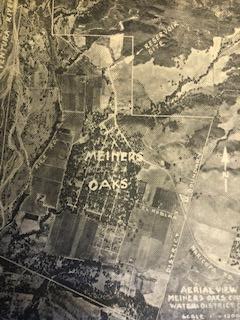
Rampaging storm damages valley
The following article was first run in the Sunday, February 12, 1978 edition of “The OJAI VALLEY NEWS” on the front page. It is reprinted here with their permission.
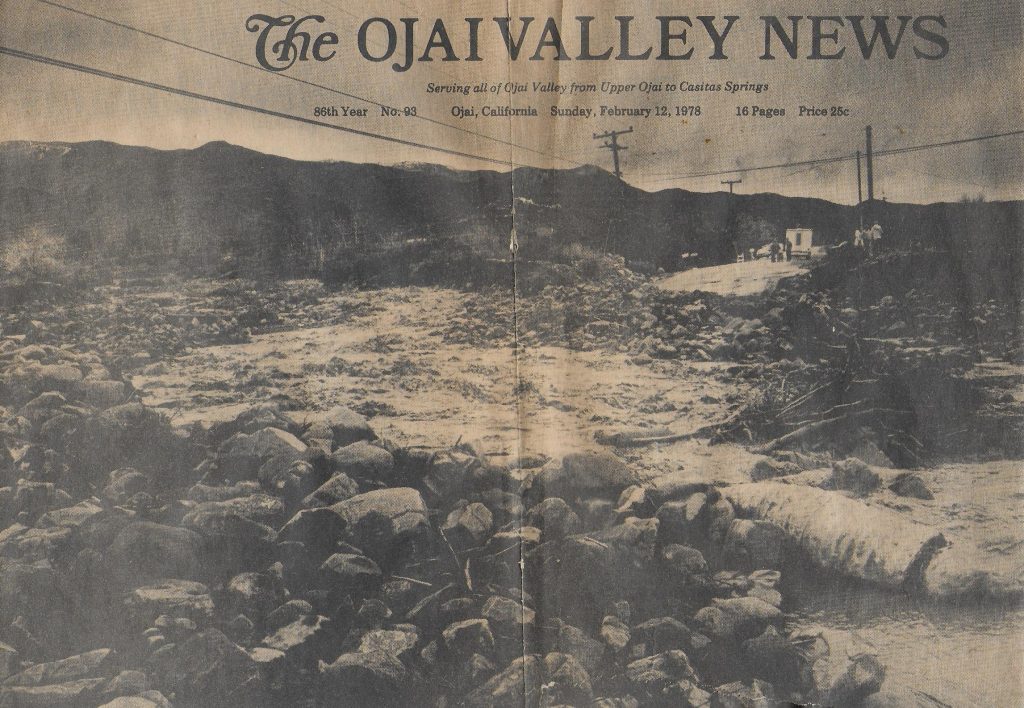
Rampaging storm damages valley
— Wind, flooding rampant —
by
Polly Bee
Ojai Valley geared for a possible repeat of the devastating floods of 1969 after a storm roared through Thursday night, dumping nearly nine inches of water in 24 hours and leaving a wake of destruction.
Undersheriff John Gillespie, as Disaster Services Chairman, declared a state of emergency Friday morning, and supervisors called an emergency session for Monday, Feb. 13 to assess damage. If destruction is as severe as it appeared Friday noon, the county could be declared a disaster area to make it eligible for state and federal assistance.
AT PRESS TIME the rampaging Ventura River, San Antonio, Lion, Matilija, and Thacher Creeks still threatened homes and property. The valley’s water supply was cut off near Casitas Springs, electricity was still out to many homes, a gas main, bridge, and sewer lines were endangered on Creek Road.
Witnesses said four homes washed into Matilija Creek in Matilija Canyon and were destroyed, at least four homes in the East End were severely damaged when Thacher Creek jumped its banks, one man died of a heart attack while sandbagging his home in Siete Robles, and eight persons were airlifted from Matilija Canyon.
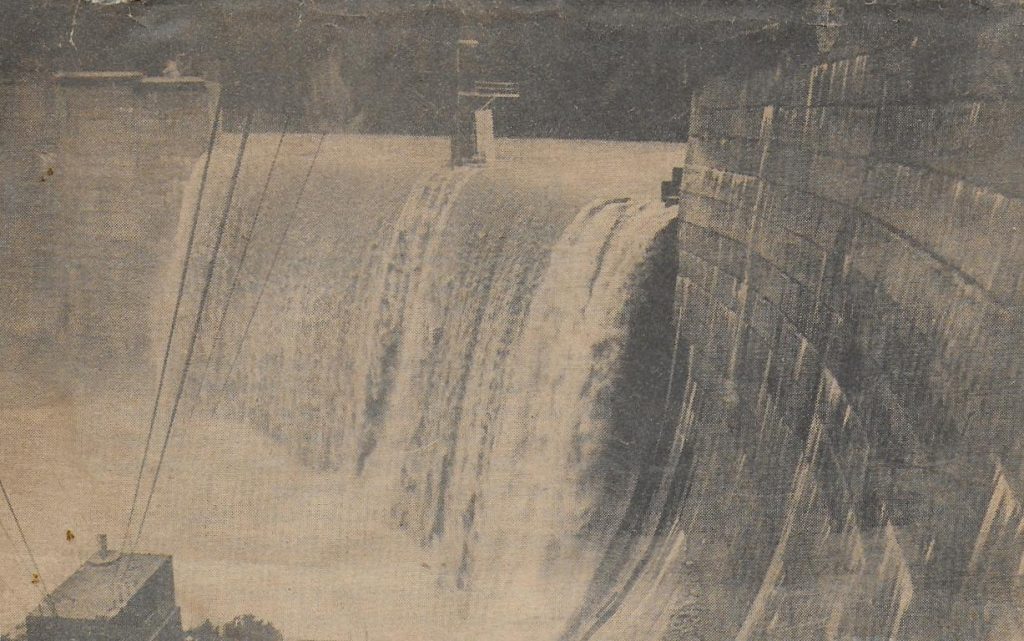
A BARGE carrying a backhoe was swept over Matilija dam, the barge eventually wedging against a gate at the Los Robles diversion dam causing a build-up of tree limbs and debris. The diversion pond in front of the canal gates completely silted so that water roared unchecked down the river. Crews were taken out Thursday night at the diversion canal because of hazardous conditions.
The Red Cross set up evacuation headquarters at Nordhoff High School to assist persons forced from their houses. At least 20 homes were abandoned in the Riverside and Santa Ana Boulevard area in Oak View after firemen and sheriff’s deputies issued warnings. Trailers in the Arroyo Trailer Park at Casitas Springs — hard hit in 1969 — were pulled away from the river bed, as floodwaters eroded embankments.
Innumerable trees toppled and power lines failed. The Edison Company said that 30,000 customers were out of service in the county Thursday night. Service still had not been restored to 5,000 by Friday noon. Officials said that power outages were greatest in the Ojai Valley because of falling trees.
AT SOULE GOLF Course floodwaters threatened the No. 5 green and took out part of the No. 10 fairway. Crossings teetered dangerously, and numerous small trees crashed. A big oak by the No. 5 green fell, as did several behind the No. 9 tee. On Friday the course was still too wet for crews to thoroughly assess damage.
Schools closed Friday because of flooded grounds and hazardous road conditions. They will remain closed Monday because of the Lincoln birthday holiday.
GRAND AVENUE bridge linking the East End to the city was isolated when San Antonio Creek washed out one approach. Roads throughout the valley were closed at intervals as streams and barrancas rampaged over culverts and bridges.
Highway 150 was closed from Lake Casitas to the county line, and from Gorham Road to Santa Paula at the height of the storm. In Upper Ojai water poured over the Ferndale bridge, which was seriously threatened. Mudslides closed Highway 33 at Wheeler Gorge.
Dead of an apparent heart attack from sandbagging his home is Wesley Frazee of 386 Avenue de la Vereda. Frazee died while trying to protect his property from floodwaters pouring off Ojai Avenue, according to reports.
Ojai’s police department was bombarded incessantly with calls reporting power outages, falling trees, flooding conditions, wind, and lightning. Public Works Director Barry Lockton said an estimated 70-100 trees and branches were reported down throughout the city. Extensive debris compounded drainage problems.
At least two Ojai homes were inundated, Lockton said. One was at the corner of Grand and Shady Lane and another in the Golden West tract. Friday roads were thick with slippery mud to make driving extremely hazardous.
ROBERT MCKINNEY, general manager of the Casitas Municipal Water District, issued a press release Friday afternoon to announce a break in the 42-inch water line that serves the entire Ojai Valley. The rupture occurred south of Casitas Springs, and the mainline was shut down Friday morning. Water in storage tanks, however, could serve valley needs for several days while a bypass line is constructed, McKinney said. Valleyites were asked to use water sparingly until full service is restored, however.
At the Grand Avenue bridge in the East End, another CMWD line was also endangered. Plans were underway to bypass it Friday with an additional line, McKinney said.
Only about 50 cubic feet of water was being diverted from the Ventura River through the Los Robles Diversion Canal Friday because of debris piled up against gates. Normally 500 cubic feet would be sent down the canal, McKinney said.
Sheriff’s deputies and firemen were called to the aid of a man in Matilija Canyon Friday night when his home was flooded. Mudslides blocked the canyon road, however, and it was not until Friday morning that the man could be flown out when eight were airlifted.
About 20 other residents elected to stay in their homes in Matilija canyon, although a major mudslide blocks access. How long it will take to remove that block was not known Friday.
The storm dumped 10.36 inches of rain in Ojai, (6.77 inches in a 24 hour period) for a total of 32.15 inches for the season. Some 13.25 inches were recorded at the Summit station for the storm total, bringing the season to date there to 31.42 inches. In Oak View, only 7.55 inches of water fell during the storm, for a season total of 28.81.
Spreading Grounds Receive Surplus Matilija Water
The following article first appeared in the Thursday, January 24, 1952 edition of “THE OJAI” on the front page. “THE OJAI” is now the “OJAI VALLEY NEWS”. The article is reprinted here with their permission. The author is unknown.
Spreading Grounds Receive Surplus Matilija Water
Water from Matilija dam was again being dumped into Ojai Valley spreading grounds this week as county officials gave their go-ahead to the opening of the conduit leading from the dam to land near the junction of Carne and Thacher roads.
Supervisor R. E. (Sam) Barrett said Tuesday that the water is surplus flood water which has been flowing over the spillway of the dam at an estimated rate of 900 million gallons per day. The cascade over the dam has somewhat lessened in the days since last week’s storm, but Barrett stated that the conduit would remain open until there is no longer surplus water in the dam. He added that the supervisors hope to continue to send water to the spreading grounds for several months.
Some doubt was expressed earlier in the week as to whether or not the water would be free enough from debris and siltation to allow its passage through the pipeline to the east end of the Valley. An inspection of the spreading grounds Wednesday noon revealed a good flow of water, only slightly discolored.
The conduit was first opened early in May last year when the county dumped some 300 acre feet of water on the spreading grounds. It was reported that some well levels in the area rose during the period the water was released.
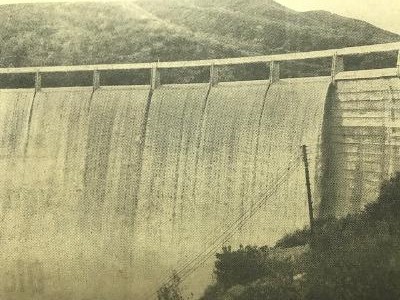
Matilija Hot Springs has Colorful History
This article was first published in the Ojai Valley News on October 22, 1994. It is used here with their permission.
MATILIJA HOT SPRINGS HAS COLORFUL HISTORY
By David Mason
“Matilija Hot Springs has had its grand opening for another season. The resort features a first class dining room, hot sulfur baths, medicinal waters, no fog and no winds. Board at the hotel is $12.00 a week and up; in tents, $2.50 a week.” – THE VENTURA FREE PRESS, MAY, 1904
Fountain of Life, Mother of Eve, Jacob’s Well and Celeste are the names of just a few of the springs that gush from the boulders in the Matilija Canyon.
When the springs were discovered in 1873 by J. W. Wilcox, he thought they might in some way be used for medicinal purposes. Wilcox camped beside the hot springs and bathed in the water for several weeks and discovered that his Mexican-War injury was slowly disappearing.
By 1875, the springs came into the ownership of R.M. Brown. With picks, spades, crowbars and an iron wheelbarrow, Brown set out to create a resort, taking advantage of the natural surroundings and the many hot and cold springs that flowed so freely out of the ground.
During the next two years, Brown built a long rambling building with a porch the entire length of its front and sides. The building became a hotel with 20 rooms to let. He also built six cabins for additional sleeping rooms.
The Arroyo Matilija, now Matilija Creek, ran behind the hotel, and there was a small footbridge to cross the river to a green meadow on the other side. In the meadow was built a large bathhouse with hot showers and sulfur baths. For an additional fee, one could even enjoy a “mud bath.” Brown then constructed a good road to his resort.
The Matilija Springs opened to the public in 1877, but not under Brown’s ownership, for he had sold the whole of the land, buildings and resort to Capt. Gardner even before the buildings were finished. Gardner gave the area the name of Matilija Springs. Gardner brought with him from San Francisco, Captain La Guad as the resorts new manager. La Guad was well known in San Francisco as a very fine chef. The guest and all the employees were very fond of the new manager.
Gardner decided to expand his operation in the canyon by bringing in hundreds of beautiful thoroughbred Angora goats. He felt that within a very short time, he would have a thriving wool-bearing ranch, however he did not take into consideration that with the low and thorny underbrush, the animals silken fur would be ruined. The goats stayed around the resort for a few years, as a great source of amusement for the guests.
In 1881, Gardner sold the springs to a Mr. Wilcoxen, from Arizona, to be used as a private home. The Wilcoxen’s had wanted a place with healing qualities because of the failing health of a grandson, Arnold Carver, who lived with them. The boy died after a serious fall, while out hunting one day. The Wilcoxen’s then opened the springs to other family members and visitors.
The resorts popularity grew as publications about the Santa Barbara and Ventura Counties included the hot springs. In 1883, Thompson and West wrote “These grounds, intersected by limpid streams, seem to have been selected by nature as a spot of earth where the chemistry of her great laboratory for the cure of diseases displays itself in great perfection. There are twenty-two of the springs and it is a remarkable fact that the quantity of water discharged never varies: It is the same in the hottest and driest spells of weather.”
The temperature of the water flowing from the springs was from 35 degrees to 150 degrees. The mountain streams were full of trout and the neighboring hills were the home of deer, quail and rabbits.
As for the health benefits, the papers wrote; “The pure mountain air, freedom from wind and dust, and the equal climate, combined with its healing waters, stimulate nature to her own best restoration processes. The effect on the healthy body of the sojourner here is to incite them to the highest mental and bodily efforts. A wholesome feeling of energy pervades and fits a man for his best and steadiest work.” The Matilija Springs resort was destroyed in the flood of 1884.
A. W. Blumberg who owned the small Blumberg Hotel in the town of Nordhoff, now Ojai, filed a claim on some of the land in the Matilija Canyon, and decided to use the springs to create a new resort and health center, appropriately call Matilija Hot Springs.
Blumberg built several small cozy cottages and furnished them for the comfort of guests. Around these cabins and among the nearby boulders, he placed tents for camping parties, and in another area, he built a stable for horses. He then built a small store for the convenience of campers and another building which was used for an office and dining room.
The new Matilija Hot Springs would now accommodate up to 100 people aside from those who had chosen to live in tents and board themselves.
Stagecoaches were the only means of public transportation to the Matilija Hot Springs, and the tourists flocked to the new resort. With so many tourists, it became necessary to open another business, the Matilija Post Office. The post office opened for business on July 22, 1889 and remained in operation for 27 years. The outlook for the future of the springs seemed very bright. All the guests were enthusiastic over the beauty of the canyon and its healing waters.
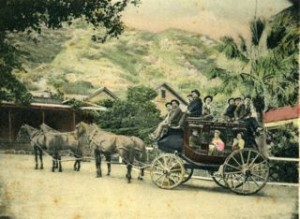
In 1901, the Blumbergs sold the resort to S. P. Creasinger, a real estate broker and developer. Creasinger paid $20,000 for the resort on eighty acres and an additional three hundred and twenty acres. By 1903, Creasinger was advertising his “Popular Summer and Winter Resort” as a “beautiful spot tendered attractive by nature (which) had been made more beautiful by the hand of artifice and the generous expenditure of money. A mammoth pleasure pavilion and numerous new cottages are among the improvements. The grounds were even illuminated by electric lights.”
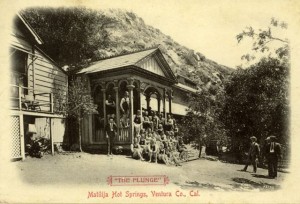
Creasinger lost the Matilija Hot Springs in a bankruptcy hearing in January 1904, and the property came into the ownership of Sim Myers of Oxnard, who purchased the place for $12,000. It would end up costing Myers more than he had anticipated. In July of 1907, Myers was charged with selling liquor without a license.
Mr. A. C. Rallya, of Chicago, a member of the Thiel Detective Agency, brought the charge against the Hot Springs. Rallya stopped at the springs for about a week and claimed to have evidence of infractions of the law. Myers, not contrary to formal charges of like character, offered no defense and the court imposed a fine on him of $300. Other charges being in evidence, the court promised Myers immunity from them, providing he would promise not to sell intoxicating drinks from now on.
The local paper, The Ojai, reporting the incident, said that they “hope that the charming resort has sufficient real attractions to afford Mr. Myers a successful career without evasion of the county ordinance.”
Then another flood raged through the canyon, with damage estimated at $50,000 to the resort’s buildings. This loss caused Myers to lose his investment. The Levy’s Bank of Oxnard took over the resort and leased it for many years, and it turned out to be a financial disaster for the bank.
In 1920, Joe Linnel, who had managed the old Blumberg Hotel in the town of Ojai, took over the Matilija Hot Springs. In 1938, G. E. Mann was in charge of the resort. Mr. and Mrs. Ray Robertson leased the Matilija Hot Springs in 1941 and ran a successful operation until 1949.
Many names of famous guests appeared on the register of the splendid “Old Western Hotel” during its years of public attraction. One of the guests was President and Mrs. Herbert Hoover, who stayed overnight and enjoyed the dining room that had achieved a reputation far and wide for its delicious food served in the atmosphere of splendor that surpassed many of the “big city” restaurants.
In 1946, the Ventura County flood control district bought the springs and the land surrounding it. The county wanted the land to build a dam in order to create a water storage lake behind the resort.
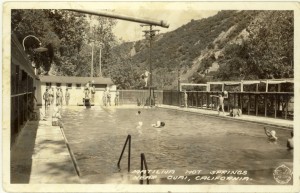
In 1965, Mr. and Mrs. Bill Olivas leased the Matilija Hot Springs resort and spa. The 1969 flood did considerable damage to the swimming pool and some of the buildings, but through the efforts of Bill Olivas, the resort was restored to its former glory.
In 1988, the county sold the property to a Santa Barbara man, and it is once more closed to the public.
Matilija Dam
Matilija and Casitas Dams by Patty Fry
The Valley’s rising population in the 1930s and 40s increased the demand for water. That demand was also evident in Ventura and in 1944, an act of the legislature formed the Ventura County Flood Control District. They employed Donald R. Warren as consulting engineer to evaluate the local water situation and he recommended a $3 million bond issue to construct a dam in the Matilija Canyon and another on Coyote Creek.
[Construction began in June, 1946.] The Matilija Dam project met with major problems. Unexpected delays, rising costs and heavy criticism plagued the job. Clay began oozing from under the dam foundation in Matilija Canyon, and the carpenters walked out. The dam was eventually deemed unsafe and a lawsuit against the engineering firm ensued. This proved to be a very costly decision.
Finally, despite all of these adversities, the site was judged safe and the workers completed the Matilija Dam in June, 1948. But the beautiful new dam stood embarrassingly empty for three years, as a severe drought was in progress. There wasn’t enough rain during that time to make more than a mud hole of the huge reservoir and that is what water customers were getting–mud. Finally, during the winter of 1951, a storm produced enough rain to fill the reservoir to capacity and the first spill occurred the following January [1952]. Conduit pipe carried water to the spreading grounds near the mouth of Senior Canyon at a rate of 1,350 gallons per minute. This water percolated into the ground and helped replenish the wells below.
By March, 1952, 44,960 acre-feet of water had been lost over the Matilija dam spillway to the ocean. It was evident that a larger facility was necessary, especially when considering the long-range water picture. In the meantime, geologists tested a dam site at Coyote Creek. A possible fault caused the project to be canceled, but after further investigation, this decision was reversed. Consultants for the flood control district recommended a 90,000 acre-foot reservoir on Coyote Creek to stop the Matilija overflow, and the project was approved.
The Federal Bureau of Reclamation completed Casitas Dam in 1959. …Casitas Municipal Water District presently operates Matilija Dam, which is owned by the Ventura County Flood Control District. No water is served to customers from this source. Lake Matilija is used primarily to store water during flood periods for later transfer to Lake Casitas.
 The above is excerpted from Patty Fry’s book The Ojai Valley: An Illustrated History. The book was updated in 2017 by Elise DePuydt and Craig Walker. It is available in the museum’s store and through Amazon.com.
The above is excerpted from Patty Fry’s book The Ojai Valley: An Illustrated History. The book was updated in 2017 by Elise DePuydt and Craig Walker. It is available in the museum’s store and through Amazon.com.


